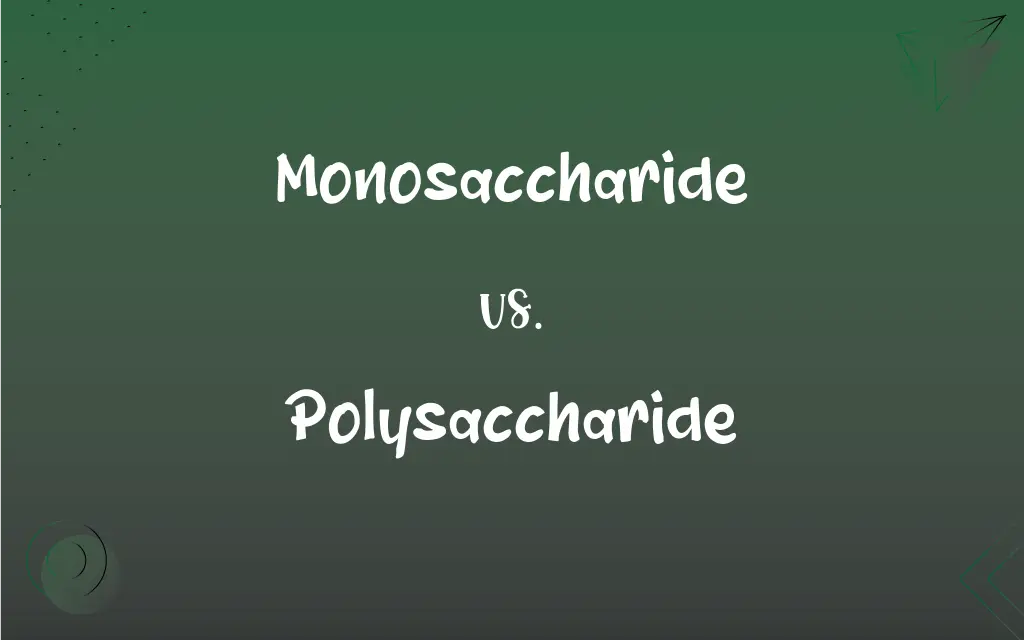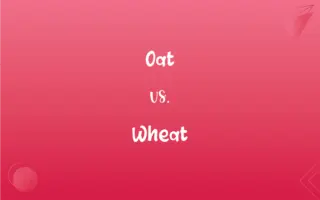Monosaccharide vs. Polysaccharide: What's the Difference?
Edited by Aimie Carlson || By Harlon Moss || Updated on October 30, 2023
A monosaccharide is a single sugar molecule like glucose, while a polysaccharide consists of multiple sugar molecules bonded together, such as starch.

Key Differences
A monosaccharide is the most basic form of carbohydrates. These simple sugars cannot be hydrolyzed to produce smaller sugar molecules. Glucose and fructose are prime examples. On the flip side, a polysaccharide is a complex carbohydrate made up of multiple monosaccharide units linked together.
The structure of a monosaccharide is typically composed of carbon, hydrogen, and oxygen in a ratio of 1:2:1. They are the building blocks for more complex carbohydrates. In contrast, polysaccharides are macromolecules formed by the linkage of numerous monosaccharide units via glycosidic bonds.
Functionally, monosaccharides are crucial for immediate energy needs in living organisms. They are rapidly metabolized and absorbed. Conversely, polysaccharides, like starch in plants or glycogen in animals, serve as energy storage units and can be broken down into monosaccharides when energy is required.
The taste of a monosaccharide is typically sweet, as can be experienced with glucose or fructose. These simple sugars can be found naturally in fruits and honey. In comparison, most polysaccharides are tasteless and are often structural components, such as cellulose in plant cell walls or chitin in insect exoskeletons.
Comparison Chart
Basic Definition
Simplest form of sugar
Complex carbohydrate
ADVERTISEMENT
Molecular Complexity
Single sugar molecule
Multiple sugar molecules bonded together
Taste
Typically sweet
Generally tasteless
Function
Immediate energy source
Energy storage or structural
Examples
Glucose, fructose
Starch, cellulose, glycogen
Monosaccharide and Polysaccharide Definitions
Monosaccharide
Monosaccharides are rapidly metabolized for energy.
The brain primarily uses the monosaccharide glucose as its energy source.
ADVERTISEMENT
Polysaccharide
Polysaccharides can function as energy storage or structural components.
Cellulose, a polysaccharide, gives plants their structural rigidity.
Monosaccharide
Monosaccharides typically have a sweet taste.
Honey is sweet due to the presence of the monosaccharide fructose.
Polysaccharide
Polysaccharides are complex carbohydrates formed by multiple sugar units.
Plants store energy in the form of the polysaccharide starch.
Monosaccharide
Monosaccharide is the simplest form of carbohydrate that can't be hydrolyzed further.
Fructose, found in fruits, is a common monosaccharide.
Polysaccharide
Polysaccharides consist of many monosaccharide molecules bonded together.
Glycogen, a polysaccharide in the liver, breaks down into glucose monosaccharide units when needed.
Monosaccharide
Monosaccharides serve as building blocks for complex carbohydrates.
Disaccharides like sucrose are formed by the combination of two monosaccharide molecules.
Polysaccharide
Polysaccharides are typically non-sweet and can be insoluble in water.
Chitin, a polysaccharide, forms the hard exoskeleton of insects.
Monosaccharide
Monosaccharide consists of a single sugar molecule.
Glucose, used for energy in cells, is a monosaccharide.
Polysaccharide
Polysaccharides can have branched or linear structures.
The polysaccharide starch can exist as the branched amylopectin or the linear amylose.
FAQs
Can polysaccharides be digested by all organisms?
Not all. For instance, humans can't digest cellulose, a polysaccharide in plant cell walls.
What's a common dietary source of monosaccharides?
Fruits, which contain the monosaccharide fructose, are a common source.
Can monosaccharides form chains?
Yes, when multiple monosaccharides bond together, they form polysaccharides.
Do monosaccharides play a role in DNA structure?
Yes, the monosaccharide deoxyribose is a component of DNA.
How are polysaccharides utilized by organisms?
Polysaccharides can be used for energy storage (like starch) or as structural components (like cellulose).
Are sugars like sucrose considered monosaccharides?
No, sucrose is a disaccharide, made of two monosaccharide units.
Are all polysaccharides energy storage molecules?
No, while some store energy (like starch), others are structural (like cellulose).
Can polysaccharides be found in animal tissues?
Yes, glycogen is a polysaccharide stored in animal liver and muscles.
What's a health benefit of consuming foods rich in monosaccharides?
They provide quick energy, though they should be consumed in moderation due to calorie content.
Which polysaccharide is used by arthropods for their exoskeleton?
Chitin is the polysaccharide used by arthropods for their hard exoskeletons.
What's the primary function of a monosaccharide in the body?
Monosaccharides serve as an immediate energy source for cells.
Are bread and rice sources of polysaccharides?
Yes, they contain starch, a type of polysaccharide.
How does the body utilize the monosaccharide glucose?
Glucose is a primary energy source, especially for the brain.
Is honey a good source of monosaccharides?
Yes, honey is rich in monosaccharides like fructose and glucose.
Which polysaccharide provides rigidity to plant cell walls?
Cellulose provides structural rigidity to plant cells.
How is lactose related to monosaccharides?
Lactose is a disaccharide made up of two monosaccharides: glucose and galactose.
Are all polysaccharides water-soluble?
No, for example, cellulose is insoluble in water.
Are monosaccharides sweet to taste?
Yes, monosaccharides, like glucose and fructose, are typically sweet.
Why can't humans digest the polysaccharide cellulose?
Humans lack the enzyme to break down cellulose's beta-glycosidic bonds.
Why are some polysaccharides used as dietary fibers?
Indigestible polysaccharides like cellulose add bulk to the diet, aiding in digestion.
About Author
Written by
Harlon MossHarlon is a seasoned quality moderator and accomplished content writer for Difference Wiki. An alumnus of the prestigious University of California, he earned his degree in Computer Science. Leveraging his academic background, Harlon brings a meticulous and informed perspective to his work, ensuring content accuracy and excellence.
Edited by
Aimie CarlsonAimie Carlson, holding a master's degree in English literature, is a fervent English language enthusiast. She lends her writing talents to Difference Wiki, a prominent website that specializes in comparisons, offering readers insightful analyses that both captivate and inform.































































